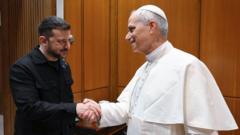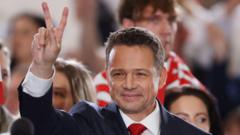The conclave, featuring a record 133 cardinals, has officially commenced in the Vatican as the Church confronts critical issues, including financial strains and sexual abuse scandals, while electing a new leader. The outcome could significantly shape the future of 1.4 billion Catholics worldwide.
Cardinals Gather for Historic Papal Conclave Amid Church Uncertainty

Cardinals Gather for Historic Papal Conclave Amid Church Uncertainty
Cardinal electors hold their first voting in the Sistine Chapel to choose a successor to Pope Francis during a time of division within the Church.
The solemn atmosphere enveloped the Sistine Chapel on May 7, 2025, as the largest gathering of cardinals in history entered for the first papal conclave in over a decade, following the death of Pope Francis just weeks prior. 133 red-robed cardinals commenced the ritualistic process of selecting the next pope, shrouded by a veil of secrecy and the chapel's renowned artistry.
Before secluding themselves—cut off from phones, the internet, and the outside world—the cardinals participated in a mass at St. Peter's Basilica, marking their last public event prior to the conclave. As the wooden doors of the Sistine Chapel closed, the cardinal electors began reciting an oath that included commitments to uphold total confidentiality throughout the process.
Among those gathered, many are meeting for the first time, adding a layer of unpredictability to the election landscape. The vote holds weight beyond merely choosing a new leader; it reflects the broader dynamics within the Catholic Church—between progressive factions advocating for inclusion and conservatively rooted factions seeking to revert reforms initiated by Pope Francis during his twelve-year papacy.
Experts speculate that the initial vote may not produce an immediate outcome, as achieving the required two-thirds majority could take additional rounds of voting. Uncertainty looms not only regarding the length of this conclave but also concerning the political alignments as many cardinals come from diverse backgrounds and perspectives.
Possible frontrunners for the papacy include Cardinal Pietro Parolin, who served as Francis’ second-in-command, and Cardinal Luis Antonio Tagle, widely recognized for his progressive stance, particularly in the rapidly growing Catholic community in the Philippines. The outcome of this conclave might effectively serve as a referendum on the legacy of Pope Francis, underscoring whether the elected pope will continue his trajectory of openness or seek a more traditionalist approach.
The conclave is characterized by a distinct blend of historic tradition and modern complexities as cardinals hold the fate of the Church in their hands, potentially facing the hardest vote to forecast amidst apparent internal divisions. Until white smoke greets the assembled crowds outside the chapel, bishops around the world will await a verdict that may usher in a new era for Catholicism.
Before secluding themselves—cut off from phones, the internet, and the outside world—the cardinals participated in a mass at St. Peter's Basilica, marking their last public event prior to the conclave. As the wooden doors of the Sistine Chapel closed, the cardinal electors began reciting an oath that included commitments to uphold total confidentiality throughout the process.
Among those gathered, many are meeting for the first time, adding a layer of unpredictability to the election landscape. The vote holds weight beyond merely choosing a new leader; it reflects the broader dynamics within the Catholic Church—between progressive factions advocating for inclusion and conservatively rooted factions seeking to revert reforms initiated by Pope Francis during his twelve-year papacy.
Experts speculate that the initial vote may not produce an immediate outcome, as achieving the required two-thirds majority could take additional rounds of voting. Uncertainty looms not only regarding the length of this conclave but also concerning the political alignments as many cardinals come from diverse backgrounds and perspectives.
Possible frontrunners for the papacy include Cardinal Pietro Parolin, who served as Francis’ second-in-command, and Cardinal Luis Antonio Tagle, widely recognized for his progressive stance, particularly in the rapidly growing Catholic community in the Philippines. The outcome of this conclave might effectively serve as a referendum on the legacy of Pope Francis, underscoring whether the elected pope will continue his trajectory of openness or seek a more traditionalist approach.
The conclave is characterized by a distinct blend of historic tradition and modern complexities as cardinals hold the fate of the Church in their hands, potentially facing the hardest vote to forecast amidst apparent internal divisions. Until white smoke greets the assembled crowds outside the chapel, bishops around the world will await a verdict that may usher in a new era for Catholicism.




















